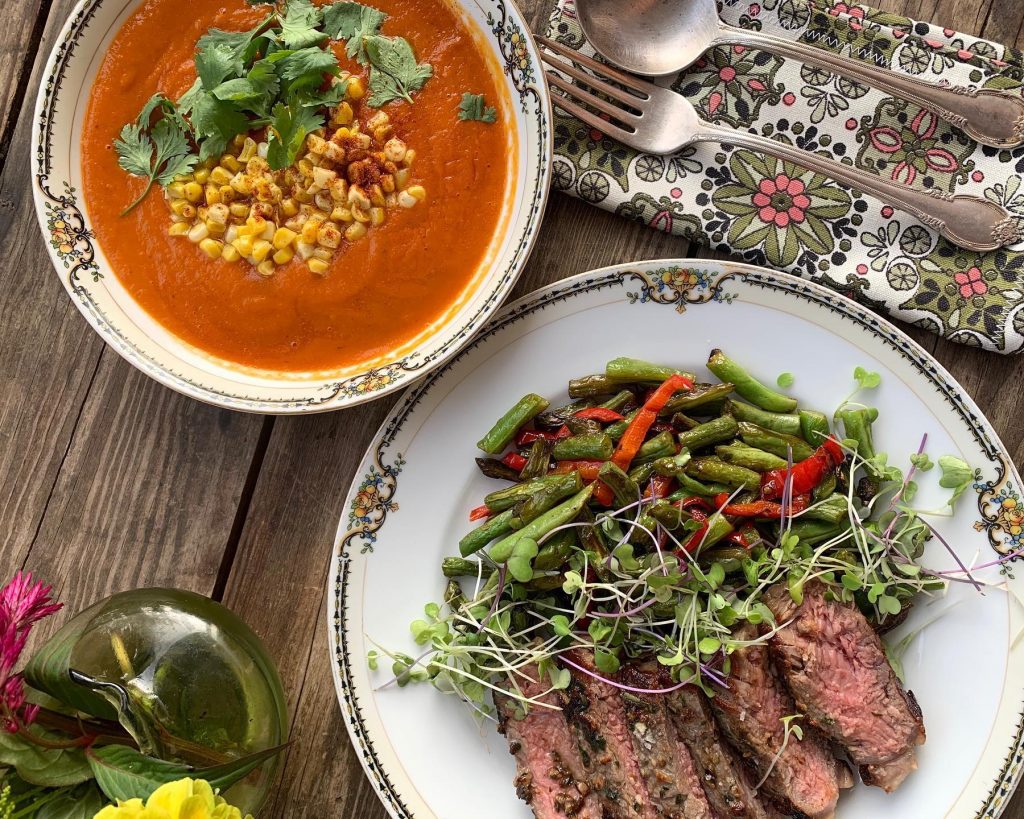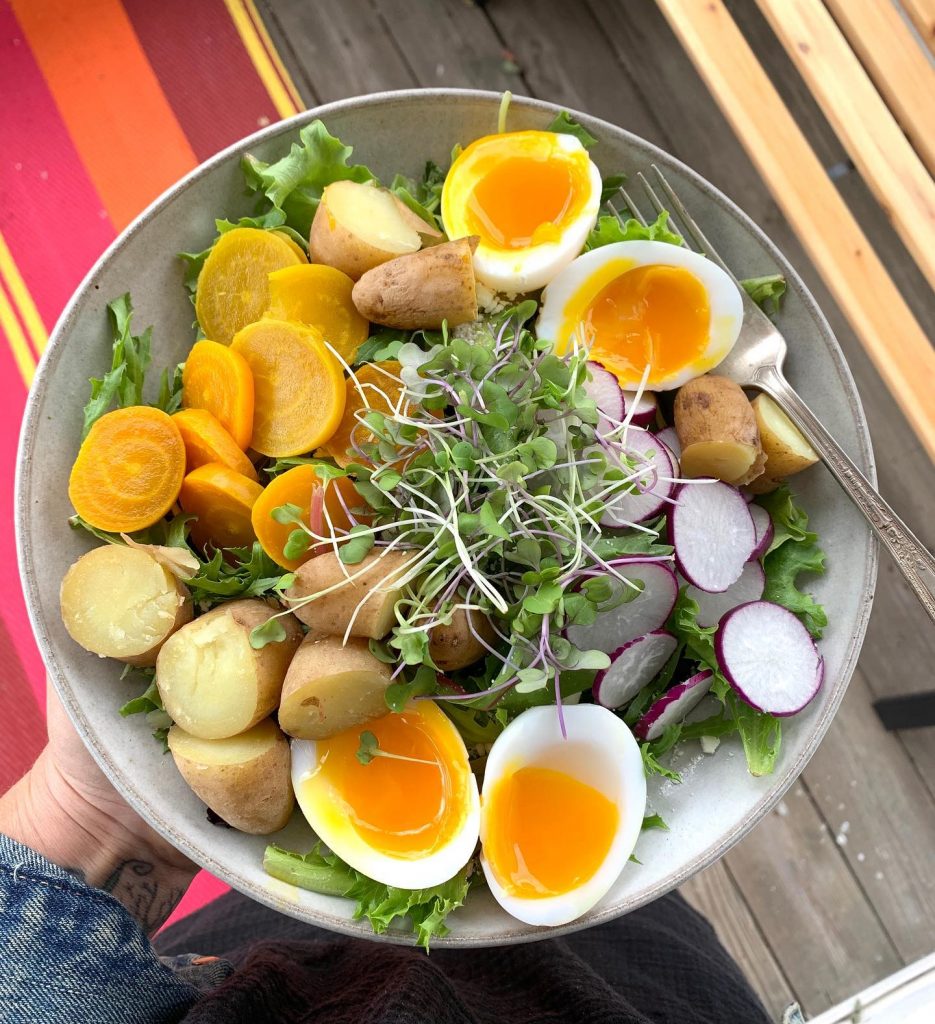March is National Nutrition Month, which is an annual campaign created by the Academy of Nutrition and Dietetics to promote making informed food choices and developing healthy food and exercise habits. While many of us would like to eat in a way that fuels our body, there’s a lot of conflicting information that makes healthy eating seem hard or unattainable.
Just think about all of the many of the most popular diets of our time – Keto, Whole30, Intermittent Fasting and Paleo, to name a few. Even before these diets were popular, we had the grapefruit diet, Atkins, and the South Beach Diet telling us how to eat. One year red meat is considered “bad” and the next “carbs” are evil, leading to a diet full of red meat. Given all of the back-and-forth, it’s easy to see why we have such a hard time deciding what to eat!
But what if it wasn’t really that hard to eat healthfully? Eating is a natural part of life. Take the bobcat as an example. Bobcats are carnivores. They prefer rabbits but also consume lizards, rodents, snakes, fowl and deer. They don’t obsess over diet and nutrition and they rely on their instincts and hunting skills to provide their own sustenance. Surely humans are smart enough to trust their own hunger cues and make decisions regarding what and when to eat.
Understanding Diet vs. Nutrition
To learn more about what truly makes a healthy diet, I reached out to two local nutrition experts to provide their perspective. But first, it’s important to understand the difference between diet and nutrition. Diet is defined as the kinds of foods that a person, animal or community habitually eats. Nutrition is the process of providing or obtaining food necessary for health and growth.
Mark Gaydos, Strength and Conditioning Coach for the Wheeling Nailers, provides athletes with valuable information regarding nutrition, which he studied when he received his bachelor’s degree in exercise science. I asked Gaydos what a common misconception regarding nutrition is that he wished would go away forever. Gaydos’ response: “that diets are short term things that you do for a couple of weeks.”
Gaydos continues, “There’s a lot of information out there about dieting, so it’s easy to get caught up in all of it and think that with so many options there has to be some way to accomplish your goals, either feeling better, looking better, improving performance etc. The only thing that short-term diets are missing out on is the actual definition of the word diet, which is ‘the kinds of foods that a person or animal habitually eats’, the key word there is habitually. Diet is the way you eat long term, not for the month before you go to the beach or after the new year. Behavior change is the key to changing your diet; you have to know why you are doing something and how it will improve your life versus just being given a grocery list and told to throw out all your potato chips.”

So, What Should I Be Eating?
Jill Spangler, Registered Dietitian and Director of Nutrition and Diabetic Services at WVU Reynolds Memorial Hospital, has been helping folks learn how to make better, sustainable food choices for over 15 years. Spangler’s number one tip when advising patients is “if it grows on a plant, eat it. If it’s made in a plant, avoid it.” This sentiment is echoed by Gaydos who states “The best way to structure any diet is based around choosing foods that are closest to their original structure when they were harvested…the less processing the better.” There is always Michael Pollen’s famous quote as well “eat food, not too much, mostly plants.”

What about superfoods? Frequently we are being marketed “superfoods” which come from far away places like avocados, cacao, moringa, turmeric and ginger. Assuming that we’ve decided to stick to our local environment and reap the benefit of these so-called “superfoods” there are actually quite a few that grow in our own region. Whole grains like spelt can be sourced locally at Weatherbury Farm and picked up directly on the farm monthly. Many area grocers offer locally-grown vegetables that pack a tremendous nutritional punch such as dark leafy greens, sweet potatoes, beets, blueberries, cruciferous vegetables, herbs and more.
The supplement market seems to be booming these days even going as far as offering nutrition in the form of pills and shakes which promise to make us healthy and young forever. I asked both Gaydos and Spangler their thoughts on receiving nutrients from supplements in place of food. Gaydos says “what’s the definition of a supplement? It is something to add to your diet when you either don’t have access to the nutrient/food you are looking for or you are allergic to the foods that may contain the nutrient you need. I only recommend supplements in these situations or in sports/athletics situations where metabolic activity and energy turnover is super high and some type of supplementation is needed to help performance.” Spangler agrees and says “it’s better to get vitamins and minerals from foods that you eat and not supplements which often contain additives and preservatives that the body doesn’t know what to do with.”
Nutrition Education is the Missing Link
Spangler and Gaydos agree that education is the missing link and a fundamental breakdown in our current culture regarding nutrition. Gaydo’s states “education is easily the missing link to making us a healthier group of people as Americans. Unfortunately, not knowing that you are setting yourself up for problems later in life by eating a diet full of processed foods is a major part of the problem; people don’t intentionally eat to become unhealthy, they simply haven’t been given the correct information about how their diet can affect their quality of life.”
Think back to the nutrition education we received in school. Many of us can recall skimming over the food groups and nutrition as a topic in elementary school and likely never formally discuss it with an educator again. Oftentimes we don’t consider nutrition until we are an adult who is being referred to a dietitian, such as Spangler, to try and reverse or mitigate disease such as diabetes.
Healthy Foods That Fit Your Budget
While we know that a diet that consists of whole, local, and minimally-processed foods is beneficial to our health and wellbeing, it can be expensive and not accessible to everyone. Spangler says that small changes can make a big difference and she works with patients and families to find a diet that fits into their budget based on their income. Gaydos adds, “behavior change takes time so changing your diet most likely won’t happen overnight; there has to be access to people that can help coach you through that process.”
Fortunately, here in Wheeling we have access to multiple stores that offer discount whole foods. To get a great deal on perfectly fine vegetables and fruits that have seen better days, the “seconds” section at Jebbia’s Market is a great place to find affordable produce. The Public Market also offers 50 percent off a selection of produce that is just past its prime. Additionally, the market provides 50 percent off of fruits and vegetables for SNAP users. Over in St. Clairsville, Aldi provides an impressive selection of organic fruits and vegetables at great prices.
In May when local farmers markets start opening up in the area you can find some amazing deals from area farms. Fruits and vegetables when they are grown locally and in season are a lot less expensive than those shipped from far away in the off season.
While food access remains an issue for many, if you have time to research and shop around for deals, you will be surprised with how affordable fresh, local produce can be.

“I Don’t Like Vegetables” and Other Hurdles to Healthy Eating
Another barrier to eating a nutrient-rich diet is a willingness to try new things. Many of us grew up scarred after being forced to eat or at least try versions of vegetables we did not find pleasing. I, for one, remember the way my dad liked to boil brussels sprouts and then serve them with vinegar – a recipe from his own family. I didn’t eat them for years and didn’t trust a brussels sprout until I had them as an adult at a restaurant in Brooklyn, NY. They were roasted with crispy bits of bacon and the roasting brought out all the sweetness and along with the salty bacon, I was hooked. If you try out new recipes for preparing foods that you didn’t like as a kid, you may find that you just didn’t like the way a parent or caregiver cooked it and discover something new!
It’s also common to get stuck in ruts with the food we eat, but there are so many amazing food blogs, cookbooks, websites and cooking classes we can use to become inspired to try whole foods in new ways. Some of my favorite whole foods and inspired vegetable cookbooks include:
Another hurdle to healthy eating is having the time and energy to prepare meals. I asked Gaydos and Spangler what their go-to meals are after a long day. Gaydos says, “it would probably be a bowl with quinoa, chickpeas, spinach or kale, goat cheese, avocado and chicken…if I have all the ingredients, which typically I do, and most of them you can prep cook and have in your fridge through the week.”
Gaydos offers some suggestions for foods that you can keep on hand for simple, fresh meals, those include “fresh fruit, bananas, apples, raw nut butters, high-quality bread from an actual bakery in the freezer, greens for a quick salad, maybe some hummus and carrots for a snack, quinoa, I like chickpea pasta and I love to cook with olive oil, grass fed butter and coconut oil, garlic and basil are nice to spice up almost any meal.”
For a quick, healthy dinner, Spangler is a big fan of breakfast for dinner. “Eggs provide an excellent source of protein and the whole family enjoys a quick and easy omelet full of fresh vegetables.”
My personal go-to is a big salad topped with a protein, which can be something I already have cooked like chicken, hard boiled eggs or canned fish. I also like to add something pickled, like onion or carrots, something crunchy, like a toasted nut or sunflower seeds, and some cooked veggies on the side, like asparagus or snap peas for the spring. I top it all with a homemade vinaigrette, which is easy to make for the week and keep in the fridge. Whole grain pasta also makes a quick and easy meal. You can toss it with some fresh grated cheese, wilted spinach and top it with a fried egg for a quick weeknight meal.

National Nutrition Month Takeaways
The theme for National Nutrition Month is “personalize your plate”, which emphasizes that we are all unique with different bodies, goals, backgrounds and tastes. Healthy eating is not a one-size-fits all approach, and what feels best for you might be completely different for someone else. The most important thing you can do is to find foods that you enjoy eating and not restrict yourself or develop a rigid set of food rules. Spangler and Gaydos agree that unless you have an allergy or you’re working with a chronic illness in which you find relief avoiding certain foods that there is no reason for you to willingly avoid entire groups of food or adopt very restrictive diets. Whole foods in balance and moderation is the key.
Happy National Nutrition Month!
• Melissa Rebholz was born and raised in Buffalo, New York, to a Sicilian/German family. She grew up in a household revolving around food. In 2007, a summer of volunteering for GrowNYC (New York City’s Farmer’s Markets) led her down the path to culinary school at The Natural Gourmet Institute and 10 subsequent years of farming from Long Island to Sonoma to Tennessee. Working simultaneously in kitchens to support her farming habit, Melissa migrated back to the rustbelt in October of 2019 to help Grow Ohio Valley open the Public Market as the head chef. Her hobbies include foraging, baking, dinner parties and exploring her new home of Wheeling, West Virginia.


